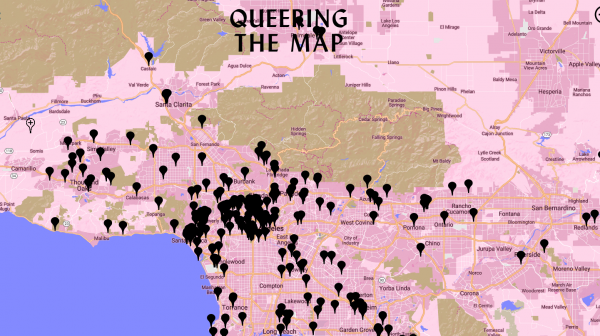
“I met my current boyfriend here. I was throwing a party for my medical recovery and we all decided to go to WeHo afterward. Thank god we did.”
— Queering the Map, West Hollywood
“We broke up, then came here anyway. You ordered the stuffed avocado like always.”
— Queering the Map, Santa Monica Boulevard on the Eastside of Los Angeles
“I saw my wife for the first time right here. We were in the staging area of the parade route for Pride and she was walking up the hill on Crescent Heights toward me when I saw her for the first time.”
— Queering the Map, near Crescent Heights Boulevard in West Hollywood.
“We broke up here. It was amazing in the beginning and not so amazing in the end. We loved each other so much, and I won’t ever regret it.”
— Queering the Map, West 4th St. near South Hill Street in downtown Los Angeles.
“We both kissed you goodbye, and it was the only time a third person felt right.”
— Queering the Map, Union Station in downtown Los Angeles.
Love, lust, heartbreak. Coming out as gay, lesbian, transgender or just plain old queer.
We all have those stories, whether in West Hollywood, Silver Lake, Paris or Tehran. One place to preserve them and share them with others is Queering the Map.
As it explains on its Facebook page, “Queering the Map is a community-generated mapping project that geo-locates queer moments, memories and histories in both cyber and physical space. ”
“As queer life becomes increasingly less centered around specific neighborhoods and the buildings within them, notions of ‘queer spaces’ become more abstract and less tied to concrete geographical locations,” the website explains. “The intent of the Queering the Map project is to collectively document the spaces that hold queer memory, from park benches to parking garages, to mark moments of queerness wherever they occur.
“There are no guidelines to what constitutes an act of queering space. If it counts to you, then it counts for Queering the Map. Anything from direct action activism to a conversation expressing preferred pronouns, from flirtatious glances to weekend long sex parties; all are part of the project of queering space. Queer history matters and elders of the community are encouraged to add moments and places of historical significance to the map that enrich our collective memory.”
Queering the Map was developed by Lucas LaRochelle. In an interview with ProjectMyopia.com, LaRochelle is described, using non-gender identified pronouns, as a multidisciplinary designer using their work as a tool to both critique contemporary culture and explore tangible alternatives…. They received a certificate in Co-Design from the Utrecht University of Applied Sciences in 2016, and are currently completing their BFA in Design and Computation Arts at Concordia University. They are a member of the Speculative Life Lab, where they research and develop projects at the intersection of the life sciences, architecture and design, and computational media.”
Queering the Map launched in February and grew rapidly, getting 6,000 posts within days. But then it was hacked by a supporter of Donald Trump, who flooded the site with “Make America Great Again” posts LaRochelle has since moved the site to a more secure server and put in place a process for moderating posts.
When the site launches in your browser, Queering The Map does not capture personal data such as a user’s location or email address so as to preserve the user’s privacy and anonymity.
That’s likely what has encouraged posts from oppressive lands such as Kazakhastan, where this was posted:
“I came out as a lesbian to my new friends in Astana. They accepted me with unbelievable warmth, and I felt safe and happy. Я сказала мой новым друзьям, что я – лесбиянка. Они были так принимающими и теплыми, что я самочувствовала себя в безопасности и очень радовалась 💜”
And then there is this sad post from Najaf in Iraq:
“Where I was first molested. I will always have some resentment towards this city and its people. Molestation is a problem that runs deep in this VERY conservative community. I hope I live to see the day that people responsible brought to justice.”
